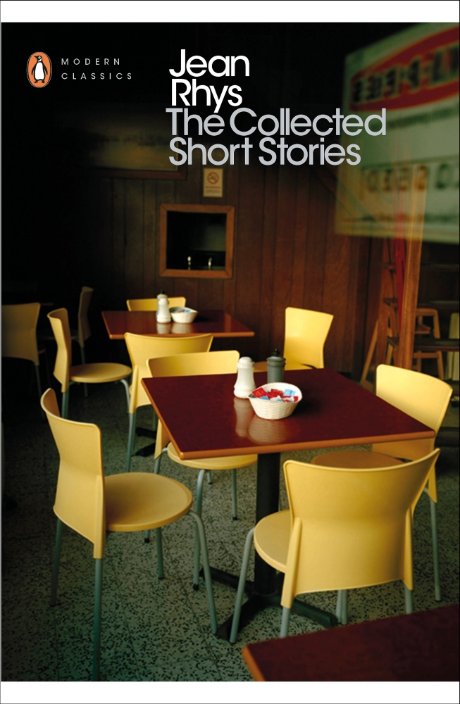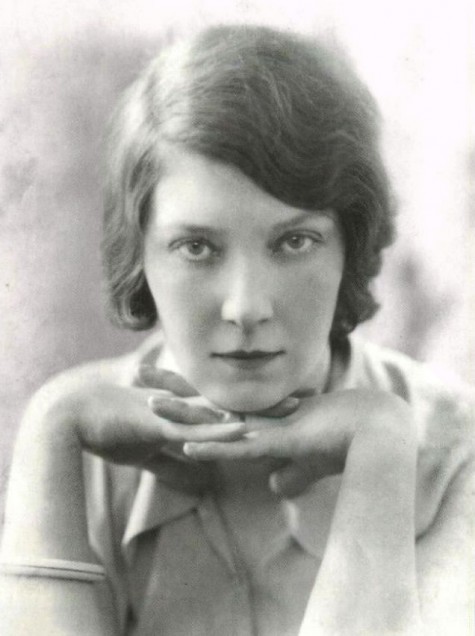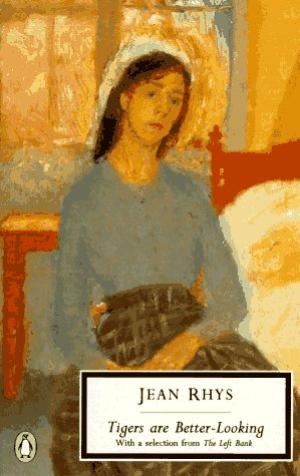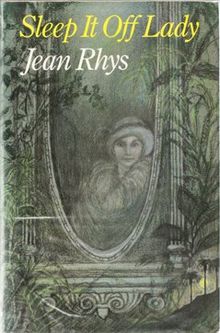Kate Jones is a freelance writer based in the North of England and has published features, reviews and essays in various places online includingThresholds, The State of the Arts, The Real Story and Skirt Collective. She has a passion for the short form, and has published many of her own flash fictions in places such as Spelk, Firefly, SickLit and Café Aphra, as well as winning the quarterly Flash500 competition and three times winner of AdHoc Fiction. Her writing has been nominated for a Pushcart Prize.
Exploring the Short Stories of Jean Rhys
Jean Rhys (1890-1979) is best known as a novelist, lesser known as a short story writer. She found fame with her last novel, Wide Sargasso Sea, (Andre Deutsch, 1966), which brought critical acclaim, Rhys having remained unpublished for over 20 years, and brought back into focus her previously published novels, often portraying life in Paris for women of little means.
I, too, have always been more familiar with Rhys’s novels: having first come to her via Wide Sargasso Sea, then going on to read her other novels set in Paris, discovering her unique voice and pithy, ironic, often sad but never dull, style.

So with Penguin due to launch a new collection of her short stories Jean Rhys The Collected Stories in March 2017, I thought it was time I investigated her short stories deeper, to see if they held as well as her novels do. I wasn’t disappointed.
A little background for the uninitiated: Born Ella Gwendoline Rhys in 1890 in Dominica to a Scottish/Creole mother and Welsh father, Rhys was sent in childhood to an English boarding school following the decline in fortune of the family business. Finding England to be a much greyer, more depressing place than she’d imagined. Rhys often felt an outsider, bullied for her Creole accent, which she staunchly refused to tone down. She endured a kind of reverse exile and left school as soon as possible to tour as a chorus girl around the North of England.
Her stories, often portraying the disenfranchisement of women living precarious lives on the edges of society, are said to mirror her own somewhat chaotic and unpredictable life. Bad choices in men, (she was married three times, two of her husband’s spending time in prison); the death of her first child at a few weeks old, something she often felt was due to her own neglect, and long periods of separation from her second child; struggling to work and becoming an alcoholic, resulting in a brief confinement in a women’s prison for psychiatric evaluation, all these clearly infiltrated her writing.
But that many commentators have chosen to portray Rhys’s life and her female fictional characters as one and the same person – claiming there to be one ‘Rhys Woman’ recycled through different texts – is not entirely the case, and takes away from the skill and complexity of Rhys’s writing.
Her literary style was highly praised on publication of her first collection and the four novels which followed. Rhys’s debut collection, The Left Bank, (Jonathan Cape, 1927), featured what would become her trademark portrayal of bohemian Paris, often women of little means, reliant on male patronage. She went on to publish four accomplished novels still working on these themes, but in a cruel twist of irony, the better she got, the less she was read. She disappeared into obscurity for over 20 years, living as something of a recluse in a Devonshire bungalow, until stories began appearing in the early 1960’s in The London Magazine, followed by Wide Sargasso Sea, which brought her acclaim and a degree of financial security at the age of 76.
The publication of this novel, appearing as it did in the 1960’s, appealed to the cultural zeitgeist questioning issues such as the exploitation of women, race, and colonialism. It also brought the issues of West Indian immigration to Britain into the public consciousness, and brought attention to Rhys as a writer.
Two more story collections came before her death in 1979, containing arguably some of the best short stories by a British writer in the last century.
The Left Bank was brought to fruition with the support of Rhys’s literary mentor, the writer Ford Madox Ford (1873-1979), whom had himself been mentored by Joseph Conrad. Ford saw such potential in her writing that he moved her into the spare bedroom of the home he shared with his wife, the artist Stella Bowen. Predictably, Ford’s intentions were not entirely based on Rhys’s writing, and an affair between the pair, reportedly with the awareness of Bowen, took place. She later wrote about this affair in her first novel, Quartet (Penguin, 1973 [1928]).
The Left Bank contains 22 stories, sadly now out of print, however several can be found within the later collection Tigers Are Better Looking (Andre Deutsch, 1968). The collection contains several pieces set in or referring to the Caribbean, such as Mixing Cocktails. Paris, the city with which Rhys is most synonymous, however, is central to the collection. Rhys is reported to have said ‘I’ve been very faithful and never really loved any other city’, when referring to Paris, after having arrived there with her first husband in 1919.
‘Hunger’ is one of the shortest stories in the collection: it is also one of the most acerbic in its ironic reminder to readers of the titillation of reading horror. ‘I have never gone without food for more than five days, so I cannot amuse you any longer’, (p182), the narrator informs us, her laconic voice throughout making the story all that more horrifying. The story sharply sets out the reality of a young woman of little means, reliving her experiences of having no money to buy food: ‘On the third day one feels sick: on the fourth one starts crying very easily…a bad habit that; it sticks’, (p182). It is difficult to read the story without feeling a degree of discomfort, and one can’t help but imagine that a young Rhys, often living on very little means and relying on the kindness of friends and lovers to pay her way, is writing this piece from experience. In a chilling, dispassionate way she tells us ‘Women are always ridiculous when they struggle’, (p182).
The collection here frequently expresses a subversive attitude to dominating characters, those who consider themselves to be superior to others. The stories introduce a major theme of Rhys’s later works of the marginalization of poor young women. There is also often the element that these women are treated indifferently by the elite. In ‘Mannequin’, Rhys portrays doll-like models, human ‘flowers’, who work for an expensive couture house in Paris: ‘A depressing room, taken by itself, bare and cold, a very inadequate conservatory for these human flowers’, (p161). The economic exploitation is delivered subversively: ‘[Madame Veron]…smiled imperiously and engaged her at an exceedingly small salary. As a beginner, Madame explained, Anna could not expect more’, (p160). This is hidden under the sheen of the pretty models displaying pretty clothes for rich foreign buyers: ‘Behind a yellow, silken screen she was hustled into a leather coat and paraded under the cold eyes of an American buyer’, (p161), and the whole story gives an account of the girls as simply commodities to sell the expensive fashions.

The stories even in this first collection demonstrate Rhys’s mastery of precision and control of language; economical, spare, terse sentences which deliver powerfully and often leave a bad taste. Her modernist style leaves gaps for the reader to fill; often less linear in structure, more a patchwork of ideas that make the reader work. Even though the stories here are accomplished however, this collection has often been seen by critics as her apprentice work, leading into her novels and later stories.
Her second collection, Tigers Are Better Looking, was published after the success of Wild Sargasso Sea, and features all previously published stories. The first half of the book (eight stories) date between 1966-67, and ten of the original stories from The Left Bank, including the ones referred to above.
The stories here show Rhys experimenting with form, point of view and narrative voice, using ellipses in some of her longer stories to convey time passing or to move between different narrative perspectives. ‘A Solid House’ and ‘The Sound of the River’ use an interesting combination of 1st and 3rd person narration, and the first person narrated stories are all female though they differ in age and cultural identity. Unlike many of her early stories, they also feature differing locations. The central themes of this collection represent the many layered complexity of human interactions and relationships; betrayals and misunderstandings. Some of the characters here are psychologically unhinged, and a central theme portrays the emotional damage suffered from the dissatisfaction of unhappy love.
In ‘Let Them Call It Jazz’, written in 1962, the central character Selina speaks in a light Creole accent. This was a bold move by Rhys, and the result is one of the finest examples in the collection. Rhys gives Selina an experience very close to her own life in this story: both Selina and Rhys quarrelled with a neighbour whilst drunk and got taken to court and sent for psychiatric evaluation. In a mirroring of Rhys’s experience, Selina is sent to Holloway Women’s Prison.

Selina’s light Creole accent is similar to Christophine’s in Wide Sargasso Sea, ‘she too cunning, and Satan don’t lie worse’, (p47). Selina’s neighbours represent the white, increasingly racist, British reaction to the increase in immigration in London in the 1960’s, and can be read as relevant to the same issues facing multiethnic communities today. ‘At least the other tarts that Crook installed here were white girls,’ (p57), the female neighbour says to her husband, and Selina relates of the male neighbour: ‘…he stare as if I’m wild animal let loose’, (p50).
There is a strong emphasis on song in this story, and this becomes more important whilst Selina is confined in Holloway, when she hears another inmate singing from the punishment cells, which she is told is ‘the Holloway song’. This comes back to her when she is released, where she has stopped singing, but now whistles the Holloway song. When a jazz pianist plays along to it, taking the tune from her, she says ‘That song was all I had. I don’t belong nowhere really,’ (p67), again mirroring Rhys’s own experience of being an outsider. Rhys’s choice in this story to make Selina working class, however, feels relevant in raising the issues experienced by immigrants at the time.
Her final collection, Sleep It Off Lady, (Penguin, 1979, [Andre Deutsch 1976]), features sixteen stories, only three of which had been previously published, and was released three years before her death in 1979 at the age of 89.
The order of the stories within this collection roughly follow the chronology and settings of Rhys’s life, set between the Caribbean, London and Paris. There is even a final story which goes beyond old age of the character returning home to the Caribbean after death as a ghost. Again, the collection displays Rhys experimenting with narrative voice and point of view.
‘Good-bye Marcus, Good-bye Rose’ fictionalises one of the ‘stories’ in Rhys’s own journals, kept in her infamous ‘black notebooks’. The third person narrator gives the story some distance yet manages to make the story more sinister in doing so, the narrator delivering the details impassively. The story centres around the sexual and emotional abuse of a young girl, Phoebe, by the visiting Captain Cardew, under the nose of both his own wife and the girl’s mother, whom direct their suspicion toward the girl rather than the Captain. ‘Do you see how white my hair is becoming? It’s all because of you’, (p28), the Captain’s wife, Edith, tells her. The story ends with Phoebe realising her childish desires of wishing to marry and have children named Marcus and Rose were now irrelevant, revealing the loss of her innocence, and the fact that deep down, she blames herself for being a victim: ‘That could only mean that he’d seen at once that she was not a good girl – who would object – but a wicked one’, (p29).
‘Rapunzel, Rapunzel’ works on the premise of the fairy tale, delivered by its first person narrator who reveals very little. The story tells of an elderly women in a convalescent home brushing her long silver-white hair, and asking if the male barber can give the ends a little trim. The barber instead chops all her hair off, ‘You’ll be glad to be rid of the weight of it, won’t you dear?’ (p143), leaving the woman bereft, losing the will to live, and there is definitely an indication of the invisibility of older women in the latter stories.

The titular story, ‘Sleep It Off Lady’, features the third person narrator correlating the world’s indifference to the elderly Miss Verney. She lives alone, having moved to a cottage in a new area and likes to have a drink. Her neighbours, we are given to understand, know about her fondness for alcohol and she feels they gossip about her. When she asks a male neighbour for help getting rid of a giant rat she has seen in the shed, as she is terrified of it, he treats her with derision, assuming she is imagining it. ‘‘Are you sure it wasn’t a pink rat?’ he said. She knew the bottles in her dustbin were counted and discussed in the village’. In a sad and inevitable outcome, Miss Verney passes out in her garden. When she asks a young local girl for help, she tells her ‘Sleep it off lady’, and skips away, leaving her cold and alone.
Many of the stories featured in all three collections were put together for The Collected Short Stories (WW Norton, 1987), edited by her friend and editor, Diana Athill.
Rhys’s many layered short stories are economical and able to accomplish a lot in a small space. Moving between the Carribean, London and Paris, through decades of life lived in these places, Rhys conjures up vivid portraits of mostly women, living life on the fringes of an often cruel or indifferent society.
Rhys said, in 1945, that her stores were ‘too bitter’…‘and besides, who wants short stories?’ To me, her writing feels as relevant today as it was when it was first written.
